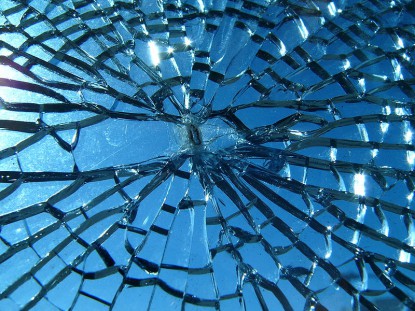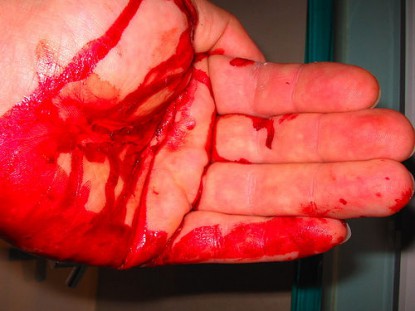glass wounds

Broken glass
Source: Wikipedia
Injuries caused by glass, for example ‘glassings’ present a mixture of irregular slash/ stab and blunt trauma wounds, where shards of glass produced on impact may puncture the skin, and larger sections of the glass cause slash-type wounds.
Incised wounds caused by shattered glass during assaults are a frequent cause of injury, and are usually accidental in nature.
Rothschild et al (2001) investigated glass puncture wounds and found that most victims were at home and had fallen against glass door panels, or against windows. Karger et al (2001) suggested that alcohol inebriation also played a substantial part in such accidents.
Glass fragments can take on many shapes – some of which bear more than a passing resemblance to knives.
For example, they may be break with a double cutting edge (like a dagger), or have a single cutting edge with a squared off back edge (like a regular household knife).
Some have almost ‘serrated’ edges, and some are long and thin resembling ‘flick knives’. The long slivers of glass cause puncture wounds that are often difficult to distinguish from stab wounds made by knives, whilst the larger sharp edges sections of glass often result in ‘slash’ type cuts.
The variety of shapes presented by broken glass also explains the varied nature of wounds arising from this mechanism of injury.
Wounds may be clean cut, often with small skin tags and notches, or irregular wounds with jagged edges that are often abraded.
Due to the involuntary actions carried out by a falling person, the injuries are often more severe, as the arms have been rapidly withdrawn back through a broken window exposing them to a second set of incised wounds.
Glass injuries can result in severe damage to skin and underlying nerves and vessels, as well as tendons, and result in significant long term disability. It is therefore vital that all such injuries are fully examined (usually under anaesthesia) for signs of neurovascular damage etc.
Karger et al (2001) also describe a case where a falling section of glazing acted as a guillotine, where a combination of cutting edge and weight resulted in severe ‘chopping’ injuries.
Historical illustration of forensic experimentation with breaking glass
Source: Science Against Crime, Kind S 1972
O’Callaghan et al (2001) described homicidal wounds caused by a shard of glass, and experimented with replica shards to see whether the defendants claims that the injuries were caused by the glass being casually thrown through a window had any merit.
They found that a force of 160 N was required to deeply penetrate tissue, and that the velocity needed to penetrate to this degree was in excess of 15.2 m/s (achievable by an overarm throw). They concluded that the defendant’s story was not sustainable.
Glass fragments may break off within the wound, and such injuries should be thoroughly investigated (under magnification if necessary) to confirm the presence of splinters that will confirm the wound aetiology. Radiography may also be of use, particularly as most household glass is radiopaque.

Glass wound to hand
Source: Flikr
Glass wounds can result in death due to exsanguination, air embolism or complications of injuries to vital structures including the brain and spinal cord.
Wounds caused by impacting upon vehicular windscreen have been considerably reduced with the increased use of vehicular restraints, but where present, they appear as small polygonal injuries.

Windscreen damage
Source: inloughborough.com
In the recent past, the use of heavy glass handled beer glasses has reduced, and these glasses were formidable weapons, due to their weight and the sharpness of the edges on breaking – often on somebody’s head or face.
Surveys at the tail end of the last Century indicated that most bar glasses had been smashed before they had caused injury, and that wounds were complicated by slivers of glass (which may or may not be radiopaque) that would need to be identified and removed to promote wound healing (and may represent a useful source of trace evidence).
references
- Karger B., Rothschild M.A., Pfeiffer H. (2001), ‘Accidental sharp force fatalities – beware of architectural glass, not knives’, Forensic Science International 123(2-3) 135-139
- O’Callaghan P.T., Jones M.D., James D.S., Leadbeatter S., Evans S.L., Nokes L.D.M. (2001), ‘A biomechanical reconstruction of a wound caused by a glass shard – a case report’, Forensic Science International 117(3) 221-231
- Rothschild M.A., Karger B., Schneider V. (2001), ‘Puncture wounds caused by glass mistaken for stab wounds with a knife’, Forensic Science International 121(3) 161-165
